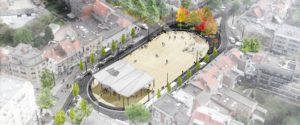New street types and signs
New forms of street are being developed in response to contemporary mobility challenges. It’s not always easy to keep abreast of these developments. Here’s a quick explanation.
Residential zone
This is a neighbourhood street where pedestrians have priority and children’s play is permitted. The speed limit for motorists is 20 km/h. Drivers must not endanger or hinder pedestrians and must stop if necessary. Pedestrians may use the whole of the public highway, but may not hinder traffic unnecessarily. Parking is only permitted in designated parking spaces (marked with a ‘P’). The street is generally level, i.e. there is no clear separation between the pavement and the roadway. Everything is at the same level, with the same surface.


Meeting zones
The same rules and signs as in a residential zone apply to an encounter zone. The main difference lies in the broader scope of the status: it is authorised in the presence of commercial, recreational, craft and educational activities, and no longer only in a residential context.

Street reserved for play
These are streets that are closed for a set period of time to allow children to play safely along the full width of the public highway. Only local residents and emergency vehicles are allowed to use the street. Find out more about the call to create a play street at this address.
>> Call for projects: creation of a play street
School street
A school street is a stretch of road closed to traffic when children are arriving and departing, generally for half an hour. The aim of this measure is to improve safety in the vicinity of the school. Only vehicles needing access to a garage and emergency vehicles will still be able to circulate.
Cycle lane
This is a street where cyclists have priority. Cyclists have the right to use the full width of the road and cannot be overtaken by motor vehicles. The speed limit is 30 km/h.
 B22 and B23 signs
B22 and B23 signs
These small triangular signs allow cyclists, under certain conditions, to turn right or continue straight ahead at a crossroads when the traffic lights are red or orange. These new signs are a major time-saver when travelling by bike. However, cyclists do not have priority over pedestrians and other road users. Traffic flows must not be interrupted.
